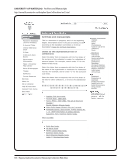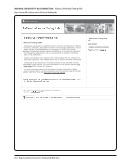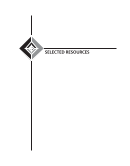SPEC Kit 307: Manuscript Collections on the Web · 63
“We have always used this approach to some degree. Each collection is evaluated and a level of processing
determined by the Manuscripts Cataloger and Processor.”
“We have moved toward a more flexible system that allows unit heads to choose the level of processing, based
on use predictions, access, donor relations, and space concerns.”
“We have occasionally done finding aids at box-level control. Finding aids are rarely done now for groups/
collections of 1.0 cu.ft. or less a detailed catalog record suffices.”
“We have revised item-level preservation activities eliminating some routine procedures such as removing
staples.”
“We have three processing levels. These are listed in the processing manual as such: Level 1: Preliminary
finding aid generation: • Intellectual control: Complete collection, file unit, and most likely item level records
in Re:discovery. Most time is spent on the narrative description and subject headings and little time on item
level. Enough information is desired to provide the researcher basic guidelines for using the material, but must
be balanced with how much time is available for this task. • Physical control: the material is not refoldered and
only reboxed if the boxes do not conform to off-site storage standards or if the boxes are damaged. Based on
the time constraint, the Re:discovery number may or may not be written on the folders. Almost no preservation
work is done. Level 2: • Intellectual control: the collection will be cataloged in Re:discovery with complete
collection, series, file unit, and item level records. • Physical control: the material will be reboxed, but primarily
not refoldered, and almost no preservation work will be done. Level 3: • Intellectual control: the collection will be
cataloged in Re:discovery with complete collection, series, file unit, and item-level records. • Physical control: the
collection will be reboxed, refoldered, and preservation such as fastener removal will be completed for each folder
and item.”
“We used similar methods and practices long before MPLP, codified in 2000 but in existence as practice long
before. Various processing levels are defined and applied from accessioning through final processing.”
“When a collection is accessioned, the Acquisitions Specialist rehouses and describes the collection at the
collection and sometimes the container level, and creates a preliminary online finding aid and bibliographic record
for the collection.”
“Yes, but to a limited degree, and usually relating to organizational records or portions of collections. Most
processing is still done to the item level and description to the folder level.”
“Yes, but we have used this ‘new approach’ for decades. As most of our professionals have had experience in
archives and especially government archives rather than in manuscript collections we use the same methods that
were described by T.R. Schellenberg and others at NARS/NARA in the late 40s and 50s.”
“Yes, MPLP involves selecting a range of possible levels of description given the materials in hand. We have
established minimal EAD encoding standards so we may begin loading brief EAD records describing materials
at the collection level. Many collections are made available on the basis of folder level preliminary inventories as
well.”
“We have always used this approach to some degree. Each collection is evaluated and a level of processing
determined by the Manuscripts Cataloger and Processor.”
“We have moved toward a more flexible system that allows unit heads to choose the level of processing, based
on use predictions, access, donor relations, and space concerns.”
“We have occasionally done finding aids at box-level control. Finding aids are rarely done now for groups/
collections of 1.0 cu.ft. or less a detailed catalog record suffices.”
“We have revised item-level preservation activities eliminating some routine procedures such as removing
staples.”
“We have three processing levels. These are listed in the processing manual as such: Level 1: Preliminary
finding aid generation: • Intellectual control: Complete collection, file unit, and most likely item level records
in Re:discovery. Most time is spent on the narrative description and subject headings and little time on item
level. Enough information is desired to provide the researcher basic guidelines for using the material, but must
be balanced with how much time is available for this task. • Physical control: the material is not refoldered and
only reboxed if the boxes do not conform to off-site storage standards or if the boxes are damaged. Based on
the time constraint, the Re:discovery number may or may not be written on the folders. Almost no preservation
work is done. Level 2: • Intellectual control: the collection will be cataloged in Re:discovery with complete
collection, series, file unit, and item level records. • Physical control: the material will be reboxed, but primarily
not refoldered, and almost no preservation work will be done. Level 3: • Intellectual control: the collection will be
cataloged in Re:discovery with complete collection, series, file unit, and item-level records. • Physical control: the
collection will be reboxed, refoldered, and preservation such as fastener removal will be completed for each folder
and item.”
“We used similar methods and practices long before MPLP, codified in 2000 but in existence as practice long
before. Various processing levels are defined and applied from accessioning through final processing.”
“When a collection is accessioned, the Acquisitions Specialist rehouses and describes the collection at the
collection and sometimes the container level, and creates a preliminary online finding aid and bibliographic record
for the collection.”
“Yes, but to a limited degree, and usually relating to organizational records or portions of collections. Most
processing is still done to the item level and description to the folder level.”
“Yes, but we have used this ‘new approach’ for decades. As most of our professionals have had experience in
archives and especially government archives rather than in manuscript collections we use the same methods that
were described by T.R. Schellenberg and others at NARS/NARA in the late 40s and 50s.”
“Yes, MPLP involves selecting a range of possible levels of description given the materials in hand. We have
established minimal EAD encoding standards so we may begin loading brief EAD records describing materials
at the collection level. Many collections are made available on the basis of folder level preliminary inventories as
well.”








































































































































































































